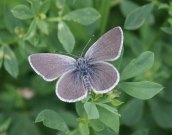
| Butterfly Conservation |
 |
| Hertfordshire & Middlesex Branch |
 |
|
|||
| Saving butterflies, moths and our environment | ||||

%20Hillbrow_22May18_SL_43.jpg)
Small BlueCupido minimusVery rare and restricted Distribution and Status In the two counties, there were concerns that the Small Blue would become extinct in the 1990s but it now appears to be doing well at Aldbury Nowers, Hillbrow (west Letchworth), the St. Albans area near the former Butterfly World site and the A41 junction at Bourne End. There are possible other colonies elsewhere where its foodplant, Kidney Vetch grows Habitat Requirements Warm and sheltered situations where the larval foodplant Kidney Vetch Anthyllis vulneraria grows on chalk and limestone grasslands, woodland clearings and coastal undercliffs. Quarries, railway embankments and roadside verges can also harbour this butterfly Larval Foodplants Kidney Vetch A. vulneraria Adult Food Sources Kidney Vetch A. vulneraria, Common Bird's-foot Trefoil Lotus corniculatus, Horseshoe Vetch Hippocrepis comosa Behaviour/Observation notes It spends most of its time close to the ground with short flights. Males hold territories on shrubs or grass tussocks often at the bottom of south-facing slopes and mating usually takes place here. After mating, females spend the rest of their lives basking, feeding or laying eggs amongst the foodplants. In dull weather, early morning or late afternoon, the butterflies can be seen roosting about 50cm above the ground on the stems of taller grasses Life History There are two generations of this butterfly but the second brood is usually much smaller. It is on the wing in May and early June, and again in August. Eggs are laid on the florets of the foodplant and there may be several on the same flowerhead. The larvae eat the developing seeds until they are ready to pupate on the ground either in mid summer or in the following spring Further information
More on life cycle and status |
Copyright Butterfly Conservation © 2019 Hertfordshire & Middlesex Branch
Privacy and Copyright Statement and Cookie Policy Statement
Butterfly Conservation
Company limited by guarantee, registered in England (2206468)
Registered Office: Manor Yard, East Lulworth, Wareham, Dorset, BH20 5QP. Tel: 01929 400 209
Charity registered in England & Wales (254937) and in Scotland (SCO39268). VAT No. GB 991 2771 89